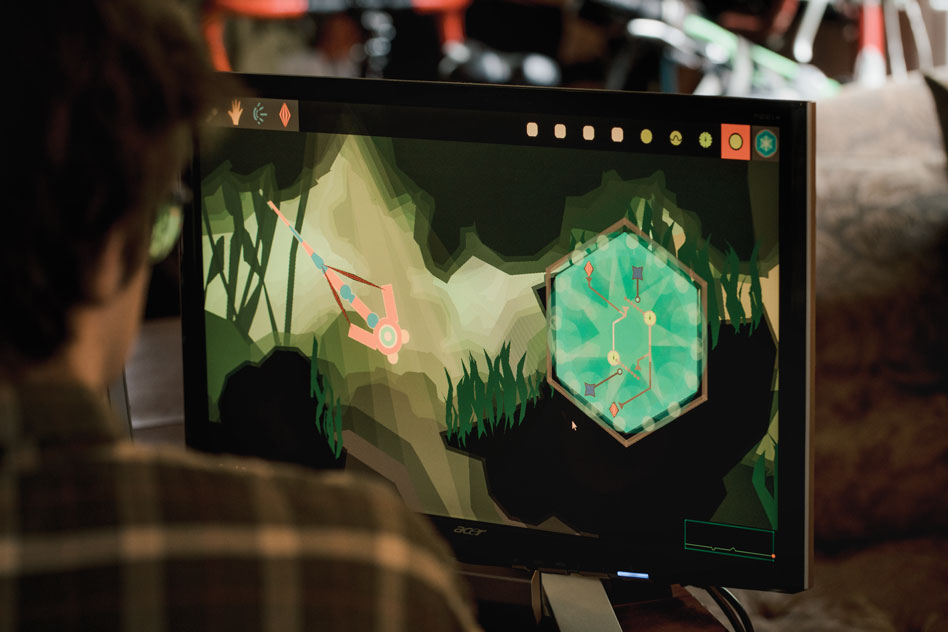
IRIS login | Reed College home Volume 96, No. 2: June 2017
Games
Inside the Mind of a Microbe

Wick works at home on Crescent Loom 12-14 hours a day but recently attended the BetaCon game expo where he won an award and gained valuable insight watching testers play his game. Photo by Clayton Cotterell
Wick Perry ’13 designed a game where players build their own creatures— and construct their brains.
By Chris Lydgate ’90
My creature is flailing.
It’s a slapdash concoction of tendon and bone, with floppy appendages and mismatched eyes. Its pathetic brain consists of nine—count ’em—nine neurons. I have armed it with stingers, harpoons, and suckers, but this arsenal has so far proven utterly worthless, because I haven’t yet figured out a much more basic problem—how to get the damn thing to propel itself through this alien ocean. Meanwhile, a sleek six-flippered monster (dubbed “the Kraken”) darts dangerously near, pulsing with menace. Unless I can find a way to rewire its brain, my creature (the “Mike-crobe”) is headed for extinction.
Welcome to Crescent Loom, a computer game designed by neuroscientist Wick Perry ’13 to introduce students to the fundamentals of brain circuitry. While the imaginary creatures in Crescent Loom may be primitive, they operate on the same principles that underlie animals in the real world, from worms to elephants to jellyfish. Connect a neuron to a muscle—when the neuron fires, the muscle contracts. Wire neurons to each other in the right way and you can build an elementary circuit that allows your creature to steer clear of obstacles or track down food.
Although the game is still in beta, it offers an experimental platform for students to peek inside a notoriously elusive subject. But the game offers something else, something that game theorists say is even more important—fun.
![]()
Wick grew up in Corbett, Oregon, a small, rural community in the Columbia Gorge. One day in middle school, he was browsing through a thrift store and bought a secondhand book titled Game Programming for Teenz. He taught himself to do some coding and produced a game about the Klondike Gold Rush of 1899. At Reed he took a course in animal physiology with the late legendary Prof. Steve Arch where he learned about neurons. “There are so many elegant ways that neurons compute information,” he says. “It was like getting the keys to how our own brains work.”
He went on to take courses in computer science and major in biology, writing his thesis with Prof. Erik Zornik [biology 2012–] on the neural mechanism by which frogs croak. He also wrote Starship Rubicon, an update of the classic arcade game Asteroids but with an underwater motif (you fight space cuttlefish and orbiting anemones).
All the while, he was dissatisfied with the way textbooks treated the mechanics of neurons. “A lot of textbooks struggle to convey the dynamics of the system,” he says. “The diagrams are static. But dynamic systems is what games are all about.”
From his work in computer science, Wick was familiar with programs that allowed students to connect logic gates to build a calculator. Why not write a program that lets you connect neurons, muscles, and sensors to build a rudimentary creature?
Crescent Loom employs an unusual “fabric” metaphor for the nervous system—players stitch muscles, weave connections, and create a network of cells. “I wanted a way to explore what happens when you poke the system,” he says. “I wanted people to see how you only need four neurons to create a creature that can flap its appendages.”

Wick’s Crescent Loom lets you connect neurons, muscles, and sensors to build a rudimentary creature.
Photo by Clayton Cotterell
At first, Wick was focused on having players build a single creature. But he soon discovered that players wanted ways to have their creatures compete with other creatures. “The first thing they do, once they’ve built a creature, is to find a more advanced creature and see what happens when they fight,” he says. “And they usually lose. But it’s OK, because it’s fun. And they learn. ‘Right, that didn’t work, let’s try this.’”
Prof. Zornik has high praise for Crescent Loom. “Wick’s project is awesome!” he says. “It holds a lot of potential for education, both for nonscientists and for early-stage neuroscientists. . . . Rather than thinking of the nervous system as a ‘black box,’ it can help anyone understand that individual units (i.e., neurons) with unique properties can combine into circuits that generate behavior.” In fact, Prof. Zornik may use the game in class next year to introduce the concepts underlying the brain’s role in generating movements.
Crescent Loom is all the more remarkable because an awful lot of so-called “educational” games are neither fun nor educational, according to game theorist Mark Chen ’95, a professor at University of Washington–Bothell. “A lot of them are designed with a worksheet model in mind,” he says. “You do an arithmetic drill, then you get to blast some aliens. But you don’t really use math to solve the problem in the game.”
Truly successful educational games, Chen thinks, help players get inside a world and work with the constraints of a particular field, whether it be urban planning or bridge construction. “We know that problem-based learning is really effective,” he says. “You learn better if you learn in a context.”
Meanwhile, Wick is working on Crescent Loom 12–14 hours a day. “I’ve learned so much,” he says over coffee at a cafe on Southeast Hawthorne Boulevard. “I just want to create something so that people can see what a neuron does. This is how we work. This is how we think.”

LATEST COMMENTS
steve-jobs-1976 I knew Steve Jobs when he was on the second floor of Quincy. (Fall...
Utnapishtim - 2 weeks ago
Prof. Mason Drukman [political science 1964–70] This is gold, pure gold. God bless, Prof. Drukman.
puredog - 1 month ago
virginia-davis-1965 Such a good friend & compatriot in the day of Satyricon...
czarchasm - 4 months ago
John Peara Baba 1990 John died of a broken heart from losing his mom and then his...
kodachrome - 7 months ago
Carol Sawyer 1962 Who wrote this obit? I'm writing something about Carol Sawyer...
MsLaurie Pepper - 8 months ago
William W. Wissman MAT 1969 ...and THREE sisters. Sabra, the oldest, Mary, the middle, and...
riclf - 10 months ago